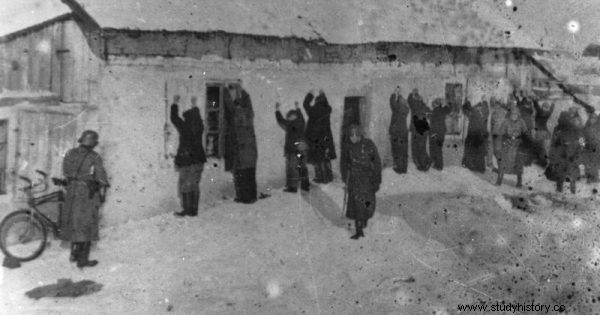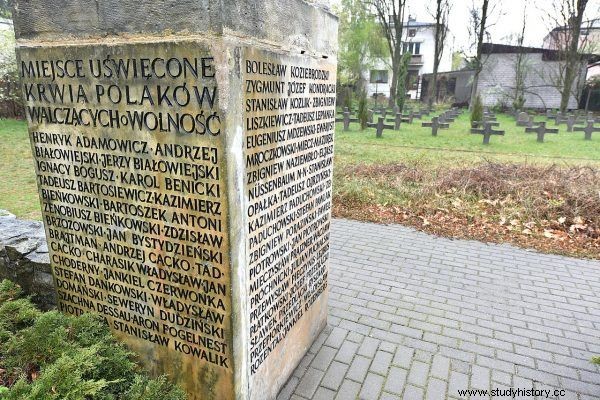In retaliation for the deaths of two Germans, over one hundred Poles were planned to be killed. However, not all of them died. One witnessed his own execution and described it in poignant detail.
The first mass public execution in Warsaw was carried out by the Germans in Wawer on December 27, 1939. It was a retaliation for the deaths of two German non-commissioned officers, shot the day before by local recidivists. The occupiers immediately organized a manhunt, but not in order to find the perpetrators of the murder.
The Germans applied the rule of collective responsibility known to Poles - local residents had to pay for the death of soldiers. The first victim of retaliation was Antoni Bartoszek, hanged without trial in the doorway of his own bar, where the shooting took place. Then about 200 random men aged 16 to 70 were pulled from nearby houses. About 110 of them (data are inconsistent) in a parody of a court hearing, officers of the 31st Order Police Regiment, Lieutenant Colonel Max Daume and Major Friedrich Wilhelm Wenzel, were sentenced to death.
"Heard two shots and felt them on my face"
One of the victims of the execution in Wawer was Second Lieutenant Jan Franciszek Warnke. However, thanks to his enormous presence of mind, he managed to survive. He later reported:
Frightened, nervous and crying people were lined up in front of a firing squad. After the volley, the soldiers walked along the lying people and, illuminating their faces with flashlights, finished off with their revolver arrows. I was in the last group. Next to me was Professor Leon Kowalik with his sixteen-year-old son who shouted:" Father, I want to live! I want to live! I don't want to die! ”

Poles waiting for execution in Wawer.
(...) I remembered the story of my uncle, Captain Witoszyński, who in 1918 escaped death in a similar situation by falling to the ground just before the volley. I had to have some free space in front of me. So I knelt half a step in front of the fence and raised both hands up as instructed. Professor Kowalik, kneeling next to me, was saying "Hail Mary" and I started singing "Poland is not yet lost while we are alive ..." and then I heard the command:"Feuer".
I immediately leaned forward and fell when hit by a bullet. I had a plucked left lung and a shot through my collarbone . I stuck my head in the snow. I heard the steps of the approaching Germans and single shots. In a moment the light of the flashlight fell on my head. I squeezed my eyes shut and prayed to Our Lady of Ostra Brama, whose gorget I had been carrying with me since my mother gave it to me when I went to the war. I believe she saved me from death. I heard two shots and felt them on my face. The bullet passed harmlessly up the neck of the head.
(…) I felt no pain. I was lying motionless in the snow. The frost caused the blood to clot and blocked its flow. It started to get light. I looked at my watch. It was 7.30 am. I listened, but there was silence. At one point something moved. It seemed to me that from among those shot, someone got up and ran.
I had a hard time standing up. I didn't notice anybody. I felt that my right hand was out of order. I walked over to the nearest house. Behind it, I saw a man without a cap with a bloodied face. What are you doing here - I asked. What are you? - also answered with a question. It was Piegat, a local hairdresser, who, like me, survived the execution.
Killed and Saved
A total of 4–7 Poles saved their lives at that time. Only one of them, Stanisław Piegat, was never hit by bullets, the rest were injured. 106 bodies were buried in the funeral ceremony conducted under the supervision of Wehrmacht soldiers.
The occupiers treated Bartoszek's body in an inhumane way. Initially, they were buried with the bodies of the remaining execution victims, but on the orders of - probably Lieutenant Colonel Daume - they were taken from the grave and hanged again over the bar's door. They were taken off only two days later and buried in their original place. At that time, German officers were coming from Warsaw, often taking pictures of the body of a Pole.

A fragment of the symbolic cemetery commemorating the victims of the crime in Wawer.
An interesting fact is that two US citizens were murdered during this execution. Another of those shot, Daniel Gering, was of German origin, which he confirmed while writing down the personal details. He reacted to the suggestions of the gendarmes to pretend to be a German.
He said he felt Polish, for which he was brutally beaten by them . He was given another chance to declare his Germanness while standing in front of the firing squad, but he did not take advantage of it this time. There were also 11 Jews among those killed.
***
Destroyed villages and cities, millions of murdered and plunder on an unimaginable scale. The horror of the German occupation in the new book by Dariusz Kaliński "Balance of harms" .
Bibliography:
The article is an excerpt from the book "Balance of harms. What did the German occupation of Poland really look like "
